Answered step by step
Verified Expert Solution
Question
1 Approved Answer
JONES MEMORIAL HOSPITAL: Competing Technologies Please fill out the chart ( fill out the zero) and answer the questions: INPUT DATA: Capital (Equipment) Cost Data:
JONES MEMORIAL HOSPITAL: Competing Technologies
Please fill out the chart ( fill out the zero) and answer the questions:
| INPUT DATA: | ||
| Capital (Equipment) Cost Data: | ||
| Water | Solid | |
| Perfusion | State | |
| Computer workstation | $0 | $0 |
| Catheters (9) | 0 | 0 |
| Volume, Revenue, and Operating Cost Data per Test: | ||
| Volume | 0 | 0 |
| Net revenue | $0 | $0 |
| Labor costs | $0 | $0 |
| Medical supply costs | ||
| Current WP system | $0 | |
| New system | $0 | $0 |
| Administrative supply costs | ||
| Current WP system | $0 | |
| New system | $0 | $0 |
| Backfill Data: | ||
| Volume (bed days) | 0 | |
| Contribution margin: | ||
| Per motility test bed-day | $0 | |
| Per medicine bed-day | $0 | |
| Other Data: | ||
| Project cost of capital | 0.0% | 0.0% |
| Inflation rate (for all) | 0.0% | |
| Market value of serviceable | $0 |
Questions: 1. What are the NPVs and IRRs of the two alternatives? What is the key factor for the more profitable alternative? 2.What is the incremental NPV of solid state versus water perfusion technology? 3. Do the two systems have the same financial risk? If not, why not? How can you modify your analysis to incorporate this differential risk? 4. What is your recommendation?
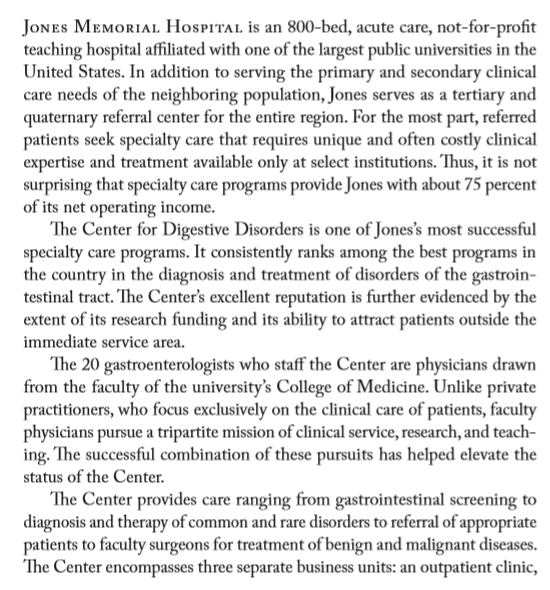
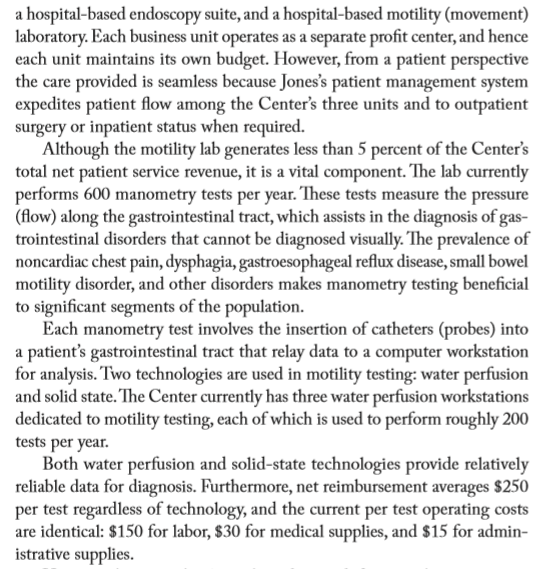
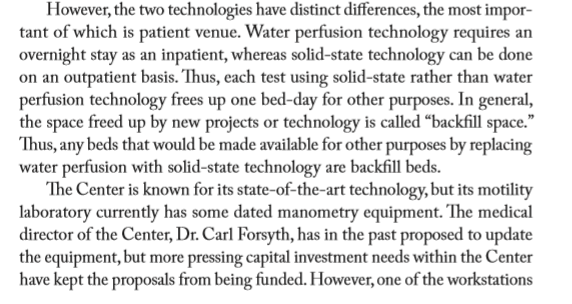
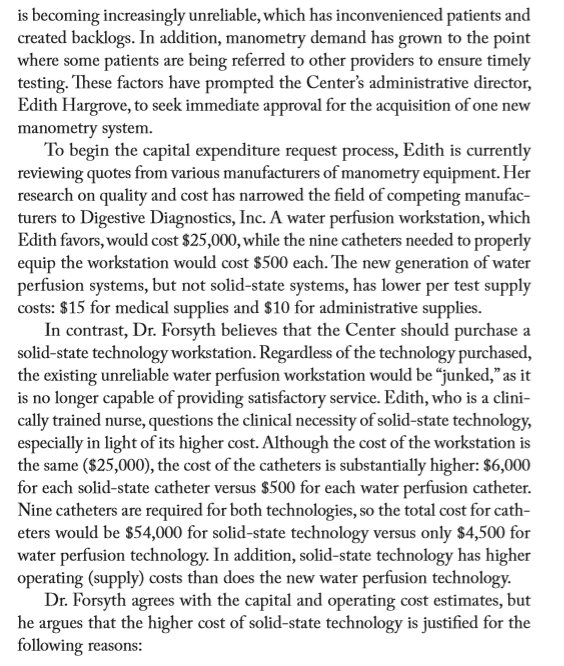
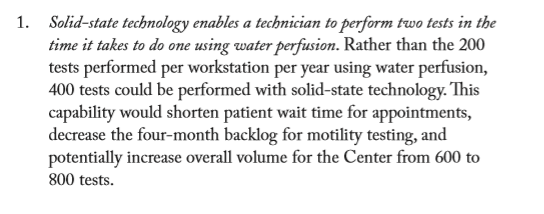
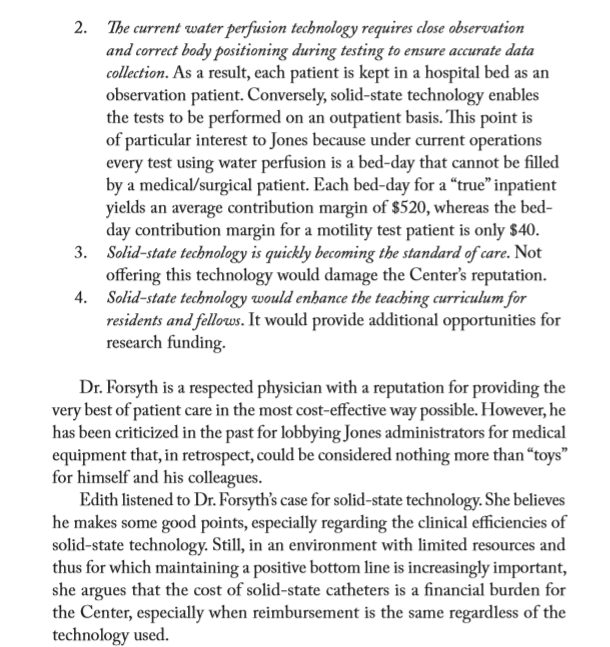
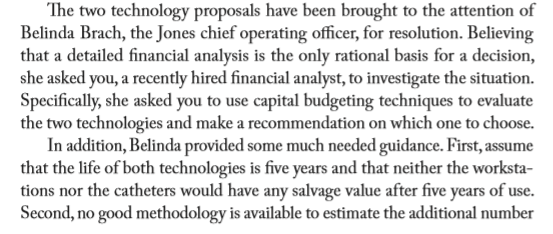
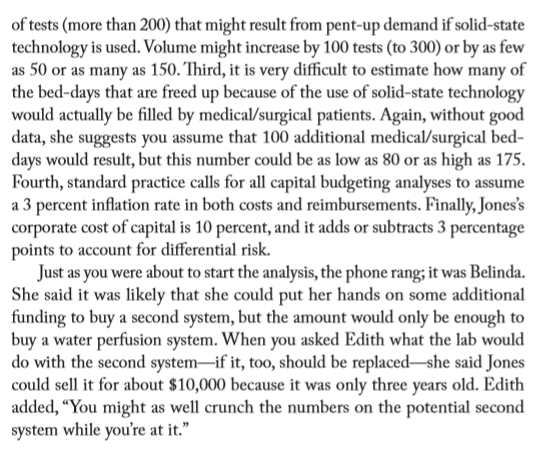
Jones Memorial Hospital is an 800-bed, acute care, not-for-profit teaching hospital affiliated with one of the largest public universities in the United States. In addition to serving the primary and secondary clinical care needs of the neighboring population, Jones serves as a tertiary and quaternary referral center for the entire region. For the most part, referred patients seek specialty care that requires unique and often costly clinical expertise and treatment available only at select institutions. Thus, it is not surprising that specialty care programs provide Jones with about 75 percent of its net operating income. The Center for Digestive Disorders is one of Jones's most successful specialty care programs. It consistently ranks among the best programs in the country in the diagnosis and treatment of disorders of the gastroin- testinal tract. The Center's excellent reputation is further evidenced by the extent of its research funding and its ability to attract patients outside the immediate service area. The 20 gastroenterologists who staff the Center are physicians drawn from the faculty of the university's College of Medicine. Unlike private practitioners, who focus exclusively on the clinical care of patients, faculty physicians pursue a tripartite mission of clinical service, research, and teach- ing. The successful combination of these pursuits has helped elevate the status of the Center The Center provides care ranging from gastrointestinal screening to diagnosis and therapy of common and rare disorders to referral of appropriate patients to faculty surgeons for treatment of benign and malignant diseases. The Center encompasses three separate business units: an outpatient clinic, a hospital-based endoscopy suite, and a hospital-based motility (movement) laboratory. Each business unit operates as a separate profit center, and hence each unit maintains its own budget. However, from a patient perspective the care provided is seamless because Jones's patient management system expedites patient flow among the Center's three units and to outpatient surgery or inpatient status when required. Although the motility lab generates less than 5 percent of the Center's total net patient service revenue, it is a vital component. The lab currently performs 600 manometry tests per year. These tests measure the pressure (flow) along the gastrointestinal tract, which assists in the diagnosis of gas- trointestinal disorders that cannot be diagnosed visually. The prevalence of noncardiac chest pain, dysphagia, gastroesophageal reflux disease, small bowel motility disorder, and other disorders makes manometry testing beneficial to significant segments of the population. Each manometry test involves the insertion of catheters (probes) into a patient's gastrointestinal tract that relay data to a computer workstation for analysis. Two technologies are used in motility testing: water perfusion and solid state. The Center currently has three water perfusion workstations dedicated to motility testing, each of which is used to perform roughly 200 tests per year. water perfusion and solid-state technologies provide relatively reliable data for diagnosis. Furthermore, net reimbursement averages $250 per test regardless of technology, and the current per test operating costs are identical: $150 for labor, $30 for medical supplies, and $15 for admin- istrative supplies. However, the two technologies have distinct differences, the most impor- tant of which is patient venue. Water perfusion technology requires an overnight stay as an inpatient, whereas solid-state technology can be done on an outpatient basis. Thus, each test using solid-state rather than water perfusion technology frees up one bed-day for other purposes. In general, the space freed up by new projects or technology is called backfill space. Thus, any beds that would be made available for other purposes by replacing water perfusion with solid-state technology are backfill beds. The Center is known for its state-of-the-art technology, but its motility laboratory currently has some dated manometry equipment. The medical director of the Center, Dr. Carl Forsyth, has in the past proposed to update the equipment, but more pressing capital investment needs within the Center have kept the proposals from being funded. However, one of the workstations is becoming increasingly unreliable, which has inconvenienced patients and created backlogs. In addition, manometry demand has grown to the point where some patients are being referred to other providers to ensure timely testing. These factors have prompted the Center's administrative director, Edith Hargrove, to seek immediate approval for the acquisition of one new manometry system. To begin the capital expenditure request process, Edith is currently reviewing quotes from various manufacturers of manometry equipment. Her research on quality and cost has narrowed the field of competing manufac- turers to Digestive Diagnostics, Inc. A water perfusion workstation, which Edith favors, would cost $25,000, while the nine catheters needed to properly equip the workstation would cost $500 each. The new generation of water perfusion systems, but not solid-state systems, has lower per test supply costs: $15 for medical supplies and $10 for administrative supplies. In contrast, Dr. Forsyth believes that the Center should purchase a solid-state technology workstation. Regardless of the technology purchased, the existing unreliable water perfusion workstation would be junked, as it is no longer capable of providing satisfactory service. Edith, who is a clini- cally trained nurse, questions the clinical necessity of solid-state technology, especially in light of its higher cost. Although the cost of the workstation is the same ($25,000), the cost of the catheters is substantially higher: $6,000 for each solid-state catheter versus $500 for each water perfusion catheter. Nine catheters are required for both technologies, so the total cost for cath- eters would be $54,000 for solid-state technology versus only $4,500 for water perfusion technology. In addition, solid-state technology has higher operating (supply) costs than does the new water perfusion technology. Dr. Forsyth agrees with the capital and operating cost estimates, but he argues that the higher cost of solid-state technology is justified for the following reasons: Solid-state technology enables a technician to perform two tests in the time it takes to do one using water perfusion. Rather than the 200 tests performed per workstation per year using water perfusion, 400 tests could be performed with solid-state technology. This capability would shorten patient wait time for appointments, decrease the four-month backlog for motility testing, and potentially increase overall volume for the Center from 600 to 800 tests. 2. The current water perfusion technology requires close observation and correct body positioning during testing to ensure accurate data collection. As a result, each patient is kept in a hospital bed as an observation patient. Conversely, solid-state technology enables the tests to be performed on an outpatient basis. This point is of particular interest to Jones because under current operations every test using water perfusion is a bed-day that cannot be filled by a medical/surgical patient. Each bed-day for a "true inpatient yields an average contribution margin of $520, whereas the bed- day contribution margin for a motility test patient is only $40. 3. Solid-state technology is quickly becoming the standard of care. Not offering this technology would damage the Center's reputation. 4. Solid-state technology would enhance the teaching curriculum for residents and fellows. It would provide additional opportunities for research funding. Dr. Forsyth is a respected physician with a reputation for providing the very best of patient care in the most cost-effective way possible. However, he has been criticized in the past for lobbying Jones administrators for medical equipment that, in retrospect, could be considered nothing more than "toys for himself and his colleagues. Edith listened to Dr. Forsyth's case for solid-state technology. She believes he makes some good points, especially regarding the clinical efficiencies of solid-state technology. Still, in an environment with limited resources and thus for which maintaining a positive bottom line is increasingly important, she argues that the cost of solid-state catheters is a financial burden for the Center, especially when reimbursement is the same regardless of the technology used. of tests (more than 200) that might result from pent-up demand if solid-state technology is used. Volume might increase by 100 tests (to 300) or by as few as 50 or as many as 150. Third, it is very difficult to estimate how many of the bed-days that are freed up because of the use of solid-state technology would actually be filled by medical/surgical patients. Again, without good data, she suggests you assume that 100 additional medical/surgical bed- days would result, but this number could be as low as 80 or as high as 175. Fourth, standard practice calls for all capital budgeting analyses to assume a 3 percent inflation rate in both costs and reimbursements. Finally, Jones's corporate cost of capital is 10 percent, and it adds or subtracts 3 percentage points to account for differential risk. Just as you were about to start the analysis, the phone rang; it was Belinda. She said it was likely that she could put her hands on some additional funding to buy a second system, but the amount would only be enough to buy a water perfusion system. When you asked Edith what the lab would do with the second systemif it, too, should be replacedshe said Jones could sell it for about $10,000 because it was only three years old. Edith added, You might as well crunch the numbers on the potential second system while you're at it. Jones Memorial Hospital is an 800-bed, acute care, not-for-profit teaching hospital affiliated with one of the largest public universities in the United States. In addition to serving the primary and secondary clinical care needs of the neighboring population, Jones serves as a tertiary and quaternary referral center for the entire region. For the most part, referred patients seek specialty care that requires unique and often costly clinical expertise and treatment available only at select institutions. Thus, it is not surprising that specialty care programs provide Jones with about 75 percent of its net operating income. The Center for Digestive Disorders is one of Jones's most successful specialty care programs. It consistently ranks among the best programs in the country in the diagnosis and treatment of disorders of the gastroin- testinal tract. The Center's excellent reputation is further evidenced by the extent of its research funding and its ability to attract patients outside the immediate service area. The 20 gastroenterologists who staff the Center are physicians drawn from the faculty of the university's College of Medicine. Unlike private practitioners, who focus exclusively on the clinical care of patients, faculty physicians pursue a tripartite mission of clinical service, research, and teach- ing. The successful combination of these pursuits has helped elevate the status of the Center The Center provides care ranging from gastrointestinal screening to diagnosis and therapy of common and rare disorders to referral of appropriate patients to faculty surgeons for treatment of benign and malignant diseases. The Center encompasses three separate business units: an outpatient clinic, a hospital-based endoscopy suite, and a hospital-based motility (movement) laboratory. Each business unit operates as a separate profit center, and hence each unit maintains its own budget. However, from a patient perspective the care provided is seamless because Jones's patient management system expedites patient flow among the Center's three units and to outpatient surgery or inpatient status when required. Although the motility lab generates less than 5 percent of the Center's total net patient service revenue, it is a vital component. The lab currently performs 600 manometry tests per year. These tests measure the pressure (flow) along the gastrointestinal tract, which assists in the diagnosis of gas- trointestinal disorders that cannot be diagnosed visually. The prevalence of noncardiac chest pain, dysphagia, gastroesophageal reflux disease, small bowel motility disorder, and other disorders makes manometry testing beneficial to significant segments of the population. Each manometry test involves the insertion of catheters (probes) into a patient's gastrointestinal tract that relay data to a computer workstation for analysis. Two technologies are used in motility testing: water perfusion and solid state. The Center currently has three water perfusion workstations dedicated to motility testing, each of which is used to perform roughly 200 tests per year. water perfusion and solid-state technologies provide relatively reliable data for diagnosis. Furthermore, net reimbursement averages $250 per test regardless of technology, and the current per test operating costs are identical: $150 for labor, $30 for medical supplies, and $15 for admin- istrative supplies. However, the two technologies have distinct differences, the most impor- tant of which is patient venue. Water perfusion technology requires an overnight stay as an inpatient, whereas solid-state technology can be done on an outpatient basis. Thus, each test using solid-state rather than water perfusion technology frees up one bed-day for other purposes. In general, the space freed up by new projects or technology is called backfill space. Thus, any beds that would be made available for other purposes by replacing water perfusion with solid-state technology are backfill beds. The Center is known for its state-of-the-art technology, but its motility laboratory currently has some dated manometry equipment. The medical director of the Center, Dr. Carl Forsyth, has in the past proposed to update the equipment, but more pressing capital investment needs within the Center have kept the proposals from being funded. However, one of the workstations is becoming increasingly unreliable, which has inconvenienced patients and created backlogs. In addition, manometry demand has grown to the point where some patients are being referred to other providers to ensure timely testing. These factors have prompted the Center's administrative director, Edith Hargrove, to seek immediate approval for the acquisition of one new manometry system. To begin the capital expenditure request process, Edith is currently reviewing quotes from various manufacturers of manometry equipment. Her research on quality and cost has narrowed the field of competing manufac- turers to Digestive Diagnostics, Inc. A water perfusion workstation, which Edith favors, would cost $25,000, while the nine catheters needed to properly equip the workstation would cost $500 each. The new generation of water perfusion systems, but not solid-state systems, has lower per test supply costs: $15 for medical supplies and $10 for administrative supplies. In contrast, Dr. Forsyth believes that the Center should purchase a solid-state technology workstation. Regardless of the technology purchased, the existing unreliable water perfusion workstation would be junked, as it is no longer capable of providing satisfactory service. Edith, who is a clini- cally trained nurse, questions the clinical necessity of solid-state technology, especially in light of its higher cost. Although the cost of the workstation is the same ($25,000), the cost of the catheters is substantially higher: $6,000 for each solid-state catheter versus $500 for each water perfusion catheter. Nine catheters are required for both technologies, so the total cost for cath- eters would be $54,000 for solid-state technology versus only $4,500 for water perfusion technology. In addition, solid-state technology has higher operating (supply) costs than does the new water perfusion technology. Dr. Forsyth agrees with the capital and operating cost estimates, but he argues that the higher cost of solid-state technology is justified for the following reasons: Solid-state technology enables a technician to perform two tests in the time it takes to do one using water perfusion. Rather than the 200 tests performed per workstation per year using water perfusion, 400 tests could be performed with solid-state technology. This capability would shorten patient wait time for appointments, decrease the four-month backlog for motility testing, and potentially increase overall volume for the Center from 600 to 800 tests. 2. The current water perfusion technology requires close observation and correct body positioning during testing to ensure accurate data collection. As a result, each patient is kept in a hospital bed as an observation patient. Conversely, solid-state technology enables the tests to be performed on an outpatient basis. This point is of particular interest to Jones because under current operations every test using water perfusion is a bed-day that cannot be filled by a medical/surgical patient. Each bed-day for a "true inpatient yields an average contribution margin of $520, whereas the bed- day contribution margin for a motility test patient is only $40. 3. Solid-state technology is quickly becoming the standard of care. Not offering this technology would damage the Center's reputation. 4. Solid-state technology would enhance the teaching curriculum for residents and fellows. It would provide additional opportunities for research funding. Dr. Forsyth is a respected physician with a reputation for providing the very best of patient care in the most cost-effective way possible. However, he has been criticized in the past for lobbying Jones administrators for medical equipment that, in retrospect, could be considered nothing more than "toys for himself and his colleagues. Edith listened to Dr. Forsyth's case for solid-state technology. She believes he makes some good points, especially regarding the clinical efficiencies of solid-state technology. Still, in an environment with limited resources and thus for which maintaining a positive bottom line is increasingly important, she argues that the cost of solid-state catheters is a financial burden for the Center, especially when reimbursement is the same regardless of the technology used. of tests (more than 200) that might result from pent-up demand if solid-state technology is used. Volume might increase by 100 tests (to 300) or by as few as 50 or as many as 150. Third, it is very difficult to estimate how many of the bed-days that are freed up because of the use of solid-state technology would actually be filled by medical/surgical patients. Again, without good data, she suggests you assume that 100 additional medical/surgical bed- days would result, but this number could be as low as 80 or as high as 175. Fourth, standard practice calls for all capital budgeting analyses to assume a 3 percent inflation rate in both costs and reimbursements. Finally, Jones's corporate cost of capital is 10 percent, and it adds or subtracts 3 percentage points to account for differential risk. Just as you were about to start the analysis, the phone rang; it was Belinda. She said it was likely that she could put her hands on some additional funding to buy a second system, but the amount would only be enough to buy a water perfusion system. When you asked Edith what the lab would do with the second systemif it, too, should be replacedshe said Jones could sell it for about $10,000 because it was only three years old. Edith added, You might as well crunch the numbers on the potential second system while you're at it.
Step by Step Solution
There are 3 Steps involved in it
Step: 1

Get Instant Access to Expert-Tailored Solutions
See step-by-step solutions with expert insights and AI powered tools for academic success
Step: 2

Step: 3

Ace Your Homework with AI
Get the answers you need in no time with our AI-driven, step-by-step assistance
Get Started


